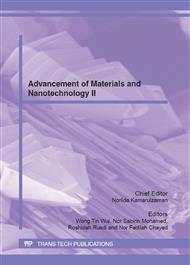p.199
p.204
p.209
p.214
p.223
p.229
p.235
p.240
p.247
Titanium Dioxide (TiO2) Films by Anodic Oxidation in Phosphoric Acid
Abstract:
Anodic oxidation is an electrochemical method for the production of an oxide film on a metallic substrate. It involves the application of an electrical bias at relatively low currents while the substrate is immersed in an acid bath. The films can be very dense and stable, with a variety of microstructural characteristics. In the present work, films of the anatase polymorph of TiO2 were formed on high-purity Ti foil (50 μm thickness) using phosphoric acid (0.3 M H3PO4). The conditions of oxidation involved the application of potentials (5 to 350 V) and current densities (5 to 60 mA.cm-2) for 10 min at room temperature. The films were characterised using a digital photography, laser Raman microspectroscopy, and field emission scanning electron microscopy. The thicknesses of the oxide films on Ti were measured using a thin film analyser based on optical spectroscopy principles. The colours, thicknesses, and microstructures of the films depended strongly on the applied voltage and current density. At bias more than 15 V, single-phase anatase was observed to form on Ti at low (5 mA.cm-2) and higher (up to 60 mA.cm-2) current density.
Info:
Periodical:
Pages:
223-228
Citation:
Online since:
July 2012
Authors:
Keywords:
Price:
Сopyright:
© 2012 Trans Tech Publications Ltd. All Rights Reserved
Share:
Citation:


